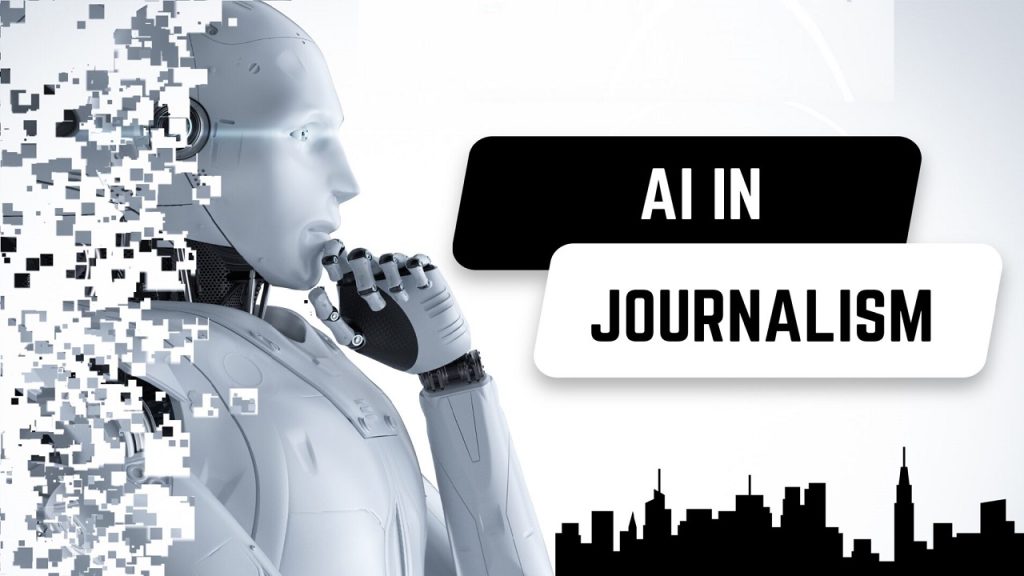AI in Journalism: Transforming the Future of News Reporting
Will AI become the new journalist? Or Will it replace the journalists? Lots of questions in the mind? We have answers for all.
Journalism is not just about news, it is a way of storytelling, doing investigations and bringing the right information to the public. In the last couple of years, AI has changed journalism to a great extent. News gathering, writing and distribution are all completed with the help of AI. Earlier, there were printing presses, then came television and then digital media has taken over everything and helped in the evolution of journalism. But now, Artificial Intelligence is bringing a new revolution.
Modern news reporting demonstrates complete transformation via advancements in artificial intelligence technology which developers never predicted during the previous decades. The implementation of AI has enabled journalists to automate repetitive work while processing large data amounts in seconds which enhances their speed intelligence and operational efficiency. This advancement creates significant moral questions about information precision together with potential news reporting partiality and the professional future of human journalists.
In this blog, we will explore how AI is changing journalism, its benefits, and challenges, and what the future holds for news reporting in the age of artificial intelligence.
How AI is Being Used in Journalism
Do you want free career counseling?
Ignite Your Ambitions- Seize the Opportunity for a Free Career Counseling Session.
- 30+ Years in Education
- 250+ Faculties
- 30K+ Alumni Network
- 10th in World Ranking
- 1000+ Celebrity
- 120+ Countries Students Enrolled
Researchers expect AI to become journalists‘ useful tool rather than their replacement. The media industry across the world adopts AI technology to enhance their news production methods. Several main applications exist where AI supports journalistic practices.
1. Automated News Writing
AI automation stands as a leading application of the technology when used for news article production. The linguistic capabilities of Wordsmith, GPT-4 and Heliograf developed by The Washington Post allow the generation of articles from structured datasets.
AI uses analytical methods to produce readable articles about financial reports, sports updates and weather forecasts quickly. News agencies including Reuters along with Bloomberg utilise AI to create automatic earnings reports and sports score announcements which require less human involvement.
Book Now →
However, AI-generated stories still lack depth, creativity, and human intuition. While they can report facts, they struggle to provide context, emotion, and investigative analysis.
2. Fact-Checking and Identifying Fake News
Misinformation spreads quickly on social media, making fact-checking more important than ever. AI tools like Google’s Fact Check Explorer, Full Fact, and ClaimBuster help journalists verify news. These tools scan large amounts of online information and compare it with trusted sources to check if the news is real or fake.
This technology enables the detection of deceptive information by identifying both falsified media files as well as manipulated content thus preserving truthful information for public access. Also, by detecting uncommon patterns in published articles AI assists reporters in selecting important reports for more detailed scrutiny.
Do you want free career counseling?
Ignite Your Ambitions- Seize the Opportunity for a Free Career Counseling Session.3. Data Analysis and Investigative Journalism
The processing speed of large datasets by AI technology takes only minutes which would need human journalists many days to weeks to complete. Investigative and Data journalism benefits greatly from AI since it allows handling extensive datasets of documents, reports, and social media posts to discover concealed patterns.
Read Also: AI in Fine Arts: Redefining Creativity in the Digital Era
AI tools like Graphika and Maltego provide journalists with capabilities to trace hidden connections in cases of political scandals and corporate frauds as well as corruption incidents.
4. Personalized News Feeds
Have you ever wondered why your news feed looks different from someone else’s? AI algorithms personalize news based on your reading habits. Platforms like Google News, Apple News, and Facebook use AI to recommend articles that match your interests.
While this enhances user experience, it also raises concerns about creating “echo chambers,” where people only see news that aligns with their beliefs, limiting exposure to diverse perspectives.
5. Transcription and Translation
Journalists often do interview recordings that require transcription services and those tasks often consume substantial amounts of time. The AI tools Otter.ai and Trint eliminate manual transcription through automatic transcription processes that produce text outputs.
Similarly, AI-powered translation tools like Google Translate and DeepL help global news agencies translate content into multiple languages, making journalism more accessible to a wider audience.
6. AI-Generated Visual Content
AI is not just limited to text; it is also being used to create visual content. News agencies are using AI to generate data-driven graphics, charts, and even video content.
For example, The Associated Press uses AI to create video summaries of major news stories, while the BBC has experimented with AI-generated weather reports. AI-powered video editing tools can also help journalists quickly create engaging multimedia content.

Read Also: Mobile Journalism: The Future of News Reporting
Benefits of AI in Journalism
AI is revolutionizing journalism by offering several advantages:
1. Faster News Reporting
AI can analyze data and generate reports in seconds, helping news agencies break stories faster than ever. This is particularly useful in time-sensitive reporting, such as election results or natural disasters.
2. Reducing Repetitive Tasks
Journalists can focus on investigative and creative work while AI handles repetitive tasks like transcribing interviews, summarizing reports, and monitoring social media trends.
3. Enhancing Accuracy
AI-powered fact-checking tools reduce the risk of publishing misinformation. By cross-referencing multiple sources, AI helps ensure that only accurate news is shared with the public.
4. Improving Audience Engagement
With AI-powered personalized recommendations, readers receive news that is relevant to their interests, leading to higher engagement levels.
5. Expanding Global Reach
Read Also: India’s Top 10 Renowned Journalists You Should Know
AI-driven translation tools enable news organizations to publish content in multiple languages, reaching a wider audience across different regions.
Challenges and Ethical Concerns
While AI has many benefits, it also presents several challenges and ethical concerns.
1. Lack of Human Touch
Content produced by AI systems demonstrates limitations in emotional depth and intuition alongside difficulties in understanding complex human experiences. Journalism moves beyond factual reporting by crafting engaging narratives that connect deeply with audiences.
2. The Risk of Bias
The learning process of AI systems consumes existing data so bias present in that information may get transmitted to their internal operations. The training of AI models with biased information can lead to biased new reports that perpetuate stereotypes and distribute false information.
3. Job Security for Journalists
Public concern exists that the implementation of AI will cause human journalists to lose their positions. The automation capabilities of AI systems do not have the ability to substitute the essential human characteristics needed to perform investigative reporting, write opinions or create extensive journalistic content.
Read Also: Impact of AI On Animation And VFX Industry
4. Ethical Concerns in AI-Generated Content
News organizations should state whether articles were composed by artificial intelligence. Openness provides the necessary foundation for keeping journalism above scrutiny from readers. Consumers of AI-generated content need to be aware of the AI involvement in maintaining trust in journalism.
5. Dependence on Technology
Journalism becomes more exposed to cyberattacks and system failure alongside data breaches when AI plays too large a role in news production. AI-driven journalism depends on continuous human supervision and checks during production to avoid any breaches.
Journalism Jobs Along With AI
The journalism industry will see new job positions arise alongside possible changes to traditional employment roles because of AI development. Future journalists need to transform their abilities to technology to maintain ethical investigative reporting practices.
Here are some key journalism jobs that will be in demand:
- AI-Assisted Reporters combine their skills with AI tools to process information for factual verification alongside content development. The assistance of AI technology helps reporters but they must retain their critical judgment abilities.
- Data Journalists function as experts to apply AI toward data collection and interpretation for creating understandable information accessible to readers. Visual data presentation through infographics together with data-based reports will increase its prevalence.
- Specialists who fact-check information are essential as misinformation spreads to defend news accuracy through verification systems powered by AI.
- Ordinary professionals with multiple media production abilities must create three to four types of content with AI tool enhancements to deliver dynamic media outputs.
- Specialists known as Ethical AI Editors supervise AI-generated content to guarantee journalistic ethics while combating bias and protecting content credibility.
- The experts who apply AI algorithms for tailoring news arrangements create personalized balanced news distribution to the audience while avoiding “echo chambers”.
While AI will handle repetitive tasks, creativity, critical thinking, and ethical journalism will always need human expertise. The future of journalism will belong to those who can blend technology with strong storytelling skills.
The Future of AI in Journalism
AI is going nowhere and it will only grow with time. In the upcoming years, we will see more use of AI, but it won’t replace the journalists but rather help them. Surely AI will act as a powerful tool that will enhance the profession.
Here are some trends we can expect in the future:
- More Collaboration Between Journalists and AI – Journalists will use AI more to gather information, for fact-checking and to analyse data. Although, human creativity will still be maintained in storytelling practices.
- Advancements in AI-Generated Content: In writing informative articles, AI will be improvised. It will write more accurate articles, with better sentence structuring to closely resemble human writing.
- Better AI Ethics and Regulations: As AI use is becoming a habitual practice in work, government and media houses will develop better and stricter guidelines to ensure the ethical use of AI.
- AI-Powered Newsrooms: AI assistants will help journalists with research work, content development, and engaging audiences.
Read Also: Shape Your Media Career with Journalism and Mass Communication
Although we can see more AI in future, the role of human journalists will stay in its place. Humans play a crucial role in news reporting and no technical advancement can replace them completely. AI can assist in collecting and processing information, but human touch will still be required to report.
Final Words
AI is truly making its way in journalism and transforming it in amazing ways. It has made the journalism process fast by quickly checking the facts, providing personalised news feeds, and automating news article writing. However, it is important to keep a check on AI use, it can be biased, and may leak some useful information. Therefore, proper guidelines for using AI will play a major role as well in shaping journalism along with AI in future.
Journalism is not just telling news to people but making a connection which AI will never accomplish because it lacks human emotions.

AAFT has been providing the world with limitless creativity and expression since 1993! Through a dynamic and industry-driven curriculum, AAFT provides engaging and captivating articles to persuasive blogs and empowers its readers to explore diverse avenues of creative media education-related content.






